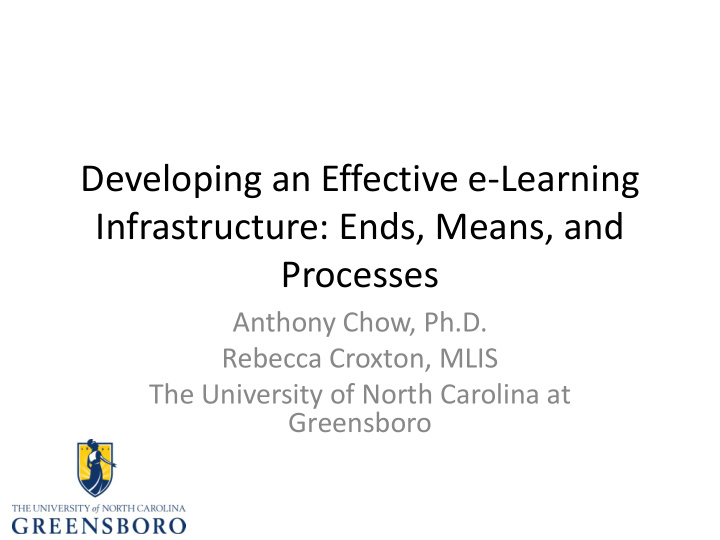



Developing an Effective e-Learning Infrastructure: Ends, Means, and Processes Anthony Chow, Ph.D. Rebecca Croxton, MLIS The University of North Carolina at Greensboro
Overview • The Project • Systems Design • School of Education Needs Assessment • Implementation Framework • Final Thoughts • Q&A
The Project • A mid-sized university in the southeastern US is preparing its faculty for increased e-Learning opportunities. • Following a systematic process utilizing systems thinking the existing needs of its six departments were assessed using mixed-methods: – Chair interviews (n=6) – Chair survey (n=5) – Faculty surveys (n=35,n=32) – Student survey (n=50)
The School of Education Counselor Education Educational Leadership Teacher Education Specialized Education Educational Research Library and Information Studies Online degree Online degree program as of program as of Fall 2013 Fall 2014
Theoretical Framework Kaufman’s Organizational Elements Model (1988): • Macro (Ends) = Clear Goals • Micro (Means) = Resources to attain goals • Process (Policy & Procedures) = Aligned policy and procedures
Organizational Elements Model (Kaufman, 1988) Inputs Processes Products Outputs Outcomes (the aggregated products of the (the effects of (en-route system that are out-puts in and (New Material) (how-to-do-its) results) delivered or for society and deliverable to the community) society) External Scope Internal (Organization) (Societal) Societal Cluster Organizational Efforts Organizational Results Results/Impacts Logic Model (Kellogg Foundation, 2004
Phase 1: Establish e-Learning Needs • Needs Assessment – Department chairs – Faculty members – Students
Students Want Option for Online Courses 1. Technology Help Desk 2. Student Support Services (e.g. advisement, real-time chat, etc.) 3. Faculty Virtual Office Hours
Faculty Highlights 1. Willing to teach an online course in the future. 2. Students in their degree programs would like the option of taking some courses online. 3. They do not feel particularly prepared to teach online. 4. They would prefer to teach a combination of f2f and online courses. 5. Online course are not of equal quality to f2f courses. 6. Teaching online courses takes more work than a face- to-face class.
Faculty (2) 2013 Follow-up Survey (1-7 scale) Total Question Responses Mean Online learning is or, will soon be, highly relevant in 31 4.9 delivering courses that I teach. I feel prepared to teach online. 32 4.8 I feel that I know how to teach online. 32 4.6 I feel confident in using technology to teach online. 32 4.5 I have enough support for teaching online. 31 4.5 Online teaching is easy for me. 32 4.3 The quality of online learning is equal to face-to-face 31 3.1 instruction. I have enough time to design and develop my online 31 2.7 courses.
Faculty – How Can We Help You? To what extent do you and/or your department need/will need the following services in support of online teaching and learning (1=disagree, 7=agree): Question Mean 1. Multimedia development for your courses. 5.6 2. Help desk real-time technology support. 5.3 3. Student technology training and orientation. 5 4. Course design. 4.7 5. Assessment of the quality of online learning. 4.7 6. Marketing and recruitment. 4.6 7. Enrollment management (e.g. class sizes). 4.5 8. Facilitating online discussions. 4.4 9. Delivering online lectures. 4.3 10. General technology skills training. 4.3 Business planning and development. 3.9 General overview of online learning. 3.6
Department Chairs – e-Learning Needs Question Chairs Faculty Faculty and department incentives 6.67 Marketing and recruitment 6.33 4.61 Course design 6 4.7 Help desk real-time technology support 6 5.29 Transitioning from F2F to online teaching and learning 6 Enrollment management for department 5.5 4.47 Existing models for online learning 5.33 Multimedia development for courses 5.33 5.57 Assessment of the quality of online learning 5 4.67 Communication and collaboration with online students 5 Advising and mentoring online students 5 Business planning and development 4.67 3.92 Trends in the field 4.67 General technology skills training 4.67 4.29 General overview of online learning 4.33 3.58 Facilitating online discussions 4 4.4 Class sizes 4 Delivering online lectures 3.5 4.33 Teacher and student satisfaction 3.5 Student technology training and orientation 3 5.03
Chair SWOT Analysis
Meeting the Identified Needs of Faculty and Students Faculty Concerns 1. I do not have enough time. 2. Online learning is not equal to f2f in quality. 3. Online teaching is not easy for me. 4. I do not have enough support for teaching online. Faculty’s Top Five Chair’s Top Five Student’s Top Three 1. Multimedia 1. Incentives 1. Help desk real-time development 2. Marketing and technology support 2. Help desk real-time Recruitment 2. Student support technology support 3. Course design services 3. Student technology 4. Help desk real-time 3. Faculty virtual training and technology support office hours orientation 5. Transitioning from 4. Course design F2F to online 5. Assessment of teaching and quality learning
Phase 2: Designing a Responsive e- Learning Support System Student’s Top Three Faculty’s Top Five Chair’s Top Five 1. Help desk real-time 1. Multimedia 1. Incentives technology support 2. Marketing and development 2. Help desk real-time 2. Student support Recruitment services 3. Course design technology support 3. Faculty virtual 3. Student technology 4. Help desk real-time office hours training and technology support 5. Transitioning from orientation 4. Course design F2F to online 5. Assessment of teaching and learning quality
Future Directions School-wide Guidelines Student Technology Orientation Unified services to departments Preliminary Incentives Satisfaction surveys and data metrics and analytics.
University e-Learning Support Services IT Services Division of Continual Learning Marketing and Recruitment Faculty and Teaching Learning Commons
Final Thoughts • Systems thinking has provided a theoretical and applicable “guiding” framework • Faculty and student needs have been assessed • Building e-Learning infrastructure takes time to evolve • Currently many misalignments between goals identified and implementation • Framework provides roadmap to where we want to go…. Ends, Means, and Processes
Thank You! • Q&A For More Information: Anthony Chow – aschow@uncg.edu Becky Croxton - racroxto@uncg.edu
Recommend
More recommend